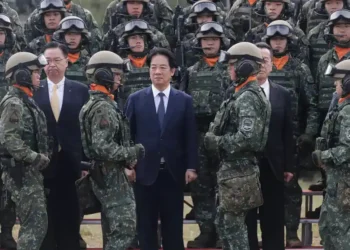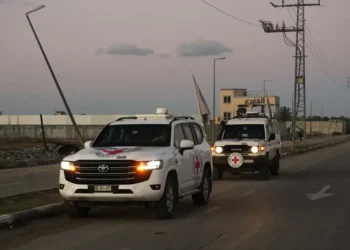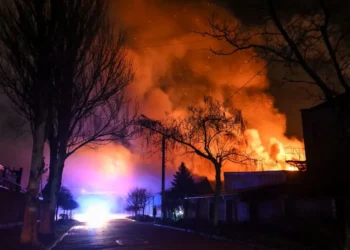China Escalates Military Drills Near Taiwan with Live-Fire Exercises
China has intensified its military activities around Taiwan, staging a second day of large-scale exercises on Wednesday. The drills included live-fire strikes in the East China Sea and simulated blockade operations near vital shipping lanes to the island’s east and west.
Beijing’s increasingly frequent and sophisticated military maneuvers serve as both preparation and strategic posturing for a potential future conflict over Taiwan, according to analysts.
The latest exercises, codenamed “Strait Thunder-2025A,” took place in the central and southern Taiwan Strait, focusing on “joint blockade and control” and “precision strikes on key targets,” according to Senior Colonel Shi Yi, spokesperson for the People’s Liberation Army (PLA) Eastern Theater Command.
As part of the drills, China’s ground forces conducted live-fire long-range strike exercises in designated areas of the East China Sea. Targets included simulated key ports and energy facilities, with the PLA claiming successful precision strikes.
Dramatic footage released by China’s military showed soldiers maneuvering rocket artillery systems into position under the cover of night before launching strikes on simulated coastal targets.
Though the PLA did not disclose the exact location of the drills, China’s Maritime Safety Administration designated a restricted area off Zhejiang province’s coast from Tuesday evening to Thursday due to military operations.
Meanwhile, to Taiwan’s east, China’s Shandong aircraft carrier group carried out separate joint exercises with PLA naval and air forces, reinforcing Beijing’s regional military presence.
Over the course of the two-day exercise, Taiwan’s defense ministry reported at least 37 Chinese aircraft crossing the median line of the Taiwan Strait—a previously respected but unofficial boundary that Beijing has increasingly disregarded in recent years.
These drills emphasized “ship-aircraft coordination, regional air superiority, and strikes on sea and land targets,” with an added focus on “multi-dimensional blockade capabilities.”
Taiwan swiftly condemned the military maneuvers as “aggressive, provocative, and irresponsible,” with its defense ministry asserting that the island’s military remains on high alert.
“Beijing’s reckless provocation of regional tensions, using global security and prosperity as bargaining chips, reveals its hegemonic mindset – one that dismisses international norms and disregards human lives,” Taiwan’s defense ministry said in a statement.
The drills come shortly after U.S. Defense Secretary Pete Hegseth’s visit to Asia, where he vowed to counter “China’s aggression.” The United States, Taiwan’s primary international backer, condemned Beijing’s actions, calling them “irresponsible threats and military pressure operations.”
“China’s escalating military intimidation tactics only serve to exacerbate tensions and undermine cross-Strait peace and stability,” the U.S. State Department declared.
For Taiwan, a self-governing democracy of 23 million people located just 80 miles from China, these exercises are a stark reminder of the persistent threat posed by its powerful neighbor, which has vowed to reunify the island—by force if necessary.
Despite the heightened military activity, daily life in Taiwan remained largely unaffected. “These drills happen so frequently they’ve become routine,” said Lin, a Taipei resident. Another local, Hawkin Yee, added, “People here are not easily frightened by this.”
The PLA characterized the exercises as a “stern warning and forceful deterrence” against Taiwan’s pro-independence forces. China’s Taiwan Affairs Office described them as “a severe punishment” for Taiwan President Lai Ching-te’s “provocations.”
In a striking display of propaganda, the PLA’s Eastern Theater Command released an animated video portraying President Lai as a cartoon bug—a “parasite” poisoning the island.
Taiwan has taken steps to bolster its defenses, with President Lai recently announcing 17 measures to counter Chinese espionage and infiltration. These initiatives include revamping the military court system for national security cases and tightening oversight on Chinese visitors.
Experts suggest China’s military drills serve both as intimidation and essential practice for an actual invasion scenario. “Amphibious assaults are among the most complex military operations. China can’t just build the ships—they have to train and gain experience,” noted David Silbey, a military history professor at Cornell University.
Silbey further warned that regular exercises could be a strategic cover for an eventual invasion, making it difficult for Taiwan and its allies to distinguish between routine drills and actual war preparations.
China has not disclosed how long these exercises will continue, but the codename “Strait Thunder-2025A” hints at a follow-up operation, “Strait Thunder-2025B,” expected later this year.
“The PLA’s Eastern Theater Command has shifted from three or four annual exercises to nearly monthly operations over the past two years,” said Carl Schuster, former director of operations at the U.S. Pacific Command’s Joint Intelligence Center. He noted that these drills are increasingly flexible, with Beijing tailoring them to fit both military and political objectives.
As tensions continue to escalate, the world watches closely for China’s next move in the Taiwan Strait.
This article was rewritten by JournosNews.com based on verified reporting from trusted sources. The content has been independently reviewed, fact-checked, and edited for accuracy, neutrality, tone, and global readability in accordance with Google News and AdSense standards.
All opinions, quotes, or statements from contributors, experts, or sourced organizations do not necessarily reflect the views of JournosNews.com. JournosNews.com maintains full editorial independence from any external funders, sponsors, or organizations.
Stay informed with JournosNews.com — your trusted source for verified global reporting and in-depth analysis. Follow us on Google News, BlueSky, and X for real-time updates.














